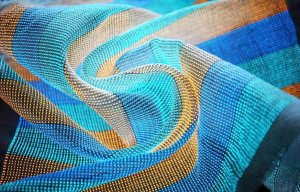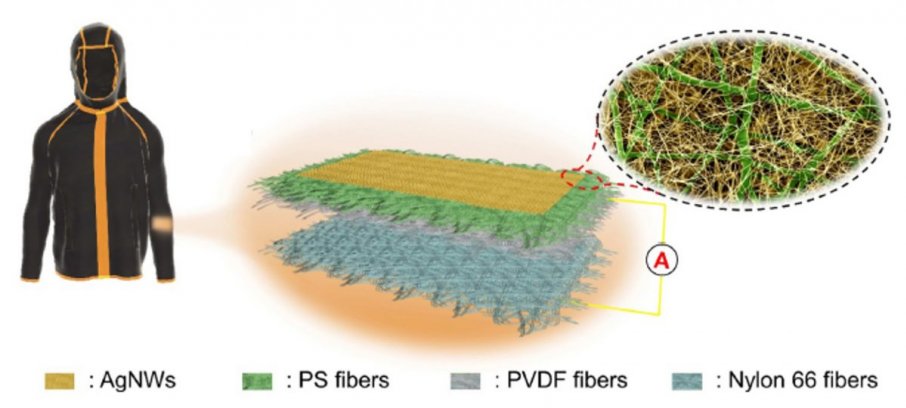
Large-area display textile integrated with functional systems
Electrospun AF-TENG triboelectric nanogenerator retains its surface charge density over time.

16th November 2021
Innovation in Textiles
|
Japan & China
Scientists at the University of Fukui in Japan and Nanjing University in China have succeeded in creating a new triboelectric fabric that generates electricity from the movement of the body while remaining flexible and breathable.
Using the movement of a body to charge electronic devices such as phones may soon become a reality, thanks to the work being done on triboelectric nanogenerators (TENGs), but most current TENGs are not breathable, making them uncomfortable to wear.
The new multilayered TENG – made from electrospun fibres, silver nanowires and a polystyrene charge storage layer – not only has a high electrical performance, but also superior wearability.
The triboelectric effect is a phenomenon where a charge is generated on two dissimilar materials when the materials are moved apart after being in contact with each other. TENGs use this effect to convert mechanical motion into electrical energy. The compactness of TENGs allows them to be used as wearable devices that can harness the motion of the body to power electronics. Being wearables, the emphasis is placed on the fabric properties (such as the comfort of the material) and the charge-carrying capacity of the nanogenerators. Generally, the triboelectric materials chosen for the nanogenerator should be safe, biocompatible, flexible and breathable while being able to maintain a high electrical output performance.
Among the many materials considered for TENGs, electrospun fibres are a promising candidate as they are lightweight, strong, and have desirable electrical properties. There are ongoing efforts to add metals to electrospun fibres to improve the electrostatic potential and charge-trapping capabilities, but this has led to compromises being made between the comfort and the output performance of the material.
AF-TENG
Details of the new all-fibrous composite layer TENG (AF-TENG), which can easily be integrated with normal fabrics, have recently been published in Nano Energy.
“The AF-TENG contains a triboelectric membrane made of two layers of electrospun fibres – one of a material called polyvinylidene fluoride (PVDF) and the other of a type of nylon,” explained Dr Hiroaki Sakamoto, who has been leading the work in Japan. “Silver nanowires cover these layers and we further added a layer of electrospun polystyrene fibres between the silver nanowires and the triboelectric membrane. The mechanical motion of the body while walking or running causes the triboelectric layers to gain a charge. This way, the mechanical energy is converted into electrical energy, which can be used to power electronic devices.”
Normally, the charge build-up on the triboelectric surface is gradually lost or dissipated, he added, reducing the surface charge density and the output performance of the nanogenerator.
“However, in this case, the polystyrene membrane collects and traps the charge, retaining the surface charge density of the AF-TENG.”
The researchers used the AF-TENG to light up 126 commercial LEDs each rated at 0.06 Watt, demonstrating the feasibility of the nanogenerator.
“The power generation device has flexibility and breathability since all components are composed of fibre materials,” Dr Sakamoto said. “This device shows great potential in harvesting the static electricity from our clothes.”
While TENGs are currently limited to powering low-powered devices such as LEDs and calculators, improvements to the wearability and output performance are integral steps towards future wearable technology.

Business intelligence for the fibre, textiles and apparel industries: technologies, innovations, markets, investments, trade policy, sourcing, strategy...
Find out more